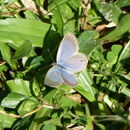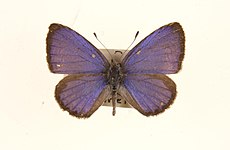pt-BR
nomes no trilho de navegação


Acytolepis puspa, the common hedge blue,[1][2] is a small butterfly found in Cambodia, India,[3] Myanmar, Thailand, Yunnan, Taiwan, Sri Lanka, Philippines, Borneo and New Guinea[4] that belongs to the lycaenids or blues family. The species was first described by Thomas Horsfield in 1828.
The butterfly was earlier known as Lycaenopsis puspa (Toxopeus).[4] It is the type species for the genus Acytolepis.[1][2][5]

Wet-season brood. male. Upperside: violaceous blue, with brilliant iridescent tints in certain lights. Forewing: the costa, apex and termen bordered with black, this edging narrows from base to the middle of the costa, then broadens greatly at apex, where it occupies the apical fourth of the wing, and is again narrowed below vein 4, whence it is continued as an even band to the tornus; on the disc beyond the apex of the cell the ground colour is sensibly paler, and the dark markings of the cell are faintly visible by transparency from below. Hindwing: the costa very broadly, the termen much more narrowly black; the black bordering on the latter consists of a series of rounded coalescent spots, which on the inner side are margined by faint dark lunules; these are formed not by actual scaling but by the dark markings of the underside which show through more or less clearly.[6]

Underside: slightly bluish white; the markings, some black, some dusky, but all large and distinct. Forewing: a short bar on the discocellulars, an anteriorly inwardly curved, transverse, discal series of seven, more or less elongate spots, of which the spot in interspace 2 is vertical and sinuous, the next above it irregularly oval and obliquely placed, the next smaller and almost round, the fourth placed almost longitudinally, forms a short bar, and the apical three decrease in size to the costa; beyond these is an inner subterminal, transverse, lunular line, an outer subterminal series of transverse spots and a very slender anteciliary line. Hindwing: two basal and three subbasal spots in vertical order; a line on the discocellulars; a spot above it at base of interspace 6; a much larger spot above that in interspace 7; a lower discal irregular transverse series of five spots, followed by terminal markings similar to those on the forewing, except that the spots in the subterminal row are rounded, not transverse. Cilia of both forewings and hindwings white alternated with dusky black at the apices of the veins. Antennae, head, thorax and abdomen dusky black, the antennae ringed with white; beneath: the palpi, thorax and abdomen white.[6]

Female: upperside: white, the bases of the wings and in some specimens the hindwing posteriorly shot with iridescent blue. Forewing: costa, apex and termen broadly black; the discocellulars marked with a very short, fine black line that extends down from the black on the costal margin. Hindwing: costa and apex broadly black; termen below vein 6 with a regular subterminal series of black spots in the interspaces, enclosed within an inner lunular and an outer straight slender anteciliary black line; the veins, except vein 5 in the middle, slenderly black. Cilia of both forewings and hindwings white. Underside: ground colour and markings similar to those of the male. Antennae, head, thorax and abdomen as in the male.[6]

Dry-season brood. Differs very slightly from the wet-season brood. In the male there is a small patch of white on the upperside of the forewing beyond the cell and on the upperside of the hindwing on the anterior portion of the disc; the extent of this patch varies on the forewing from a mere touch of white just beyond the cell to a large discal area of white which is diffuse with ill-defined margins. In the female the blue iridescence at the base of the wings on the upperside is in some specimens considerably restricted, in others entirely absent. On the underside in both sexes the ground colour is paler and in form and position the markings are much less prominent, though entirely like those of the wet-season brood.[6][7]
The butterfly occurs in Peninsular India, Himalayas, Assam, Andamans, Nicobars, Sri Lanka, Cambodia, Myanmar,[4][8] Taiwan, Philippines, Borneo,[9] Sulawesi[10] and New Guinea.[1]
Reported as common by Wynter-Blyth in India.[8] Reported as rare in Andamans to very rare in Nicobars.
The larva has been recorded on Glochidion fortunei, Rhododendron species, Distylium racemosum, Rosa multiflora, Rosa wichuraina, Rosa centifolia, Prunus zippeliana, Glochidion obovatum, Myrica rubra, Quercus phillyraeoides, Celtis sinensis, Astilbe thunbergii, Schleichera oleosa, Hiptage benghalensis and Xylia dolabriformis.[1]
Acytolepis puspa, the common hedge blue, is a small butterfly found in Cambodia, India, Myanmar, Thailand, Yunnan, Taiwan, Sri Lanka, Philippines, Borneo and New Guinea that belongs to the lycaenids or blues family. The species was first described by Thomas Horsfield in 1828.
Acytolepis puspa, atau Common Hedge Blue, adalah kupu-kupu yang termasuk dalam kelompok keluarga Lycaenidae dan sub-keluarga Lycaeninae.
Kupu-kupu ini pada awalnya dikenali sebagai Lycaenopsis puspa (Toxopeus).[1] Ia merupakan spesies jenis bagi genus Acytolepis.[2][3][4]
Acytolepis puspa, atau Common Hedge Blue, adalah kupu-kupu yang termasuk dalam kelompok keluarga Lycaenidae dan sub-keluarga Lycaeninae.
Acytolepis puspa is een vlinder uit de familie van de Lycaenidae.[1] De wetenschappelijke naam van de soort is voor het eerst geldig gepubliceerd in 1828 door Horsfield.
Bronnen, noten en/of referentiesヤクシマルリシジミ(屋久島瑠璃小灰蝶、Acytolepis puspa)は、チョウ目(鱗翅目)シジミチョウ科ヒメシジミ亜科に分類される蝶の一種。
ルリシジミとよく似ている。また前翅最前縁の脈が中室端まで伸びるなどの差異がある。翅裏は一様な明灰色で、外周にそって黒点がならぶ。雄の翅表は構造色で青色に輝く。
幼虫の食草はノイバラ・テリハノイバラ・バクチノキ(バラ科)・イスノキ(マンサク科)。幼虫はつぼみや新芽を食べるので、親蝶はその付近に産卵する。
成虫は年4回ほど発生、越冬態は不定。冬以外はほぼいつでも見られる。花によく来るほか、湿地帯ではときに吸水集団をつくる。市街地の街路樹で発生することもある。
紀伊半島南端、徳島県、九州南部以南と南西諸島に分布。国外では東洋区。